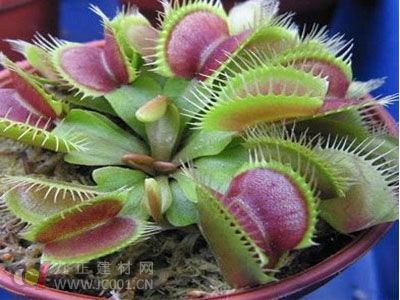Flytrap Growing Techniques:
Lighting: Flytraps are native to swampy areas where they receive plenty of direct sunlight. When growing them at home, provide full sun during spring, fall, and winter. In summer, especially in the south, it’s best to offer partial shade (about 50%) or place them on a sunny windowsill indoors. If natural light is limited, you can use artificial lighting—position a 40W fluorescent lamp about 30 cm above the plant for 12 hours daily.
Water: Use soft water like distilled or rainwater. A popular method called "wet tray" (common in Hong Kong and Taiwan) mimics their natural habitat. Place the pot in a tray or glass jar filled with 3 cm of water, and keep the soil consistently moist. This helps maintain the right moisture level for the plant.
Humidity: Maintain humidity above 50%. Since flytraps thrive in swamp-like conditions, using a large water tray with the wet tray method can increase local humidity. You can also place a layer of live moss on top of the soil to help retain moisture in the air.

Soil Mix: Use a mix of peat moss without added fertilizer, combined with perlite or gravel in a 1:1 ratio, or pure sphagnum moss. Replace the soil every spring. Keep in mind that flytraps prefer acidic conditions. When planting, make sure the bottom of the pot has some drainage holes or is broken up to prevent waterlogging.
Temperature: They grow best between 15°C and 35°C, with an ideal range of 21°C to 35°C. If you want them to go dormant in winter, keep the temperature around 5°C (0–8°C). However, based on experience, many plants can survive without dormancy and still thrive the following year.
Feeding: Don’t overfeed your flytrap. They will catch their own prey. Only feed them small arthropods like insects or spiders, and limit it to one or two leaves per feeding. Their digestive enzymes aren’t designed for large meat pieces like beef or chicken.
Fertilizing: Carnivorous plants have sensitive root systems and are not tolerant of fertilizers. Applying fertilizer directly to the soil can kill the plant. Instead, use a diluted liquid fertilizer (about 1/5th of the recommended strength) on the foliage once every two weeks during the growing season.
V Opening Valve Balls,Stainless Three L Port Valve Spheres,Stainless Three T Port Valve Spheres,Stainless V Port Valve Spheres
WENZHOU ZHENHONG VALVE BALL CO., LTD , https://www.zhvalveball.com